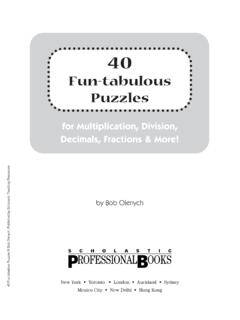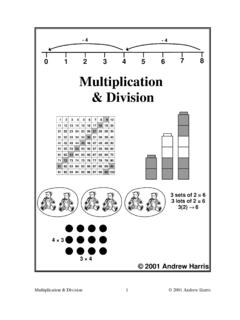Transcription of FRACTION REVIEW
1 Business Math Study Guide 2 Page 1 FRACTION REVIEW A. INTRODUCTION 1. What is a FRACTION ? A FRACTION consists of a numerator (part) on top of a denominator (total) separated by a horizontal line. For example, the FRACTION of the circle which is shaded is: 2 (parts shaded) 4 (total parts) In the square on the right, the FRACTION shaded is 83 and the FRACTION unshaded is 85 FRACTION = numerator denominator 2. Equivalent fractions Multiplying The three circles on the right each have equal parts shaded, yet are represented by different but equal fractions . These fractions , because they are equal, are called equivalent fractions . Any FRACTION can be changed into an equivalent FRACTION by multiplying both the numerator and denominator by the same number 21 = 42 or 21 84 so 844221 Similarly 95 = 1810 or 95 = 2715 so 95 = 1810 = 2715 You can see from the above examples that each FRACTION has an infinite number of fractions that are equivalent to it.
2 84 42 21 x 2 x 2 x 3 x 3 x 2 x 2 x 4 x 4 = Business Math Study Guide 2 fractions FB/2015 Page 2 3. Equivalent fractions Dividing (Reducing) Equivalent fractions can also be created if both the numerator and denominator can be divided by the same number (a factor) evenly. This process is called reducing a FRACTION by dividing a common factor (a number which divides into both the numerator and denominator evenly). 214484 93998127 6155305 5322106 4. Simplifying a FRACTION (Reducing to its Lowest Terms) It is usual to reduce a FRACTION until it can t be reduced any further. A simplified FRACTION has no common factors which will divide into both numerator and denominator. Notice that, since 27 and 81 have a common factor of 9, we find that 93 is an equivalent FRACTION . But this FRACTION has a factor of 3 common to both numerator and denominator.
3 So, we must reduce this FRACTION again. It is difficult to see, but if we had known that 27 was a factor (divides into both parts of the FRACTION evenly), we could have arrived at the answer in one step 3188248 4315156045 93998127 313393 3127278127 Business Math Study Guide 2 fractions FB/2015 Page 3 5. EXERCISE 1: Introduction to fractions a) Find the missing part of these equivalent fractions Example: 53 = 10 Since 5 x 2 = 10, multiply the numerator by 2, also. So, 53 = 106 1) 32 = 6 2) 43 = 12 3) 85 = 40 4) 161 = 32 5) 152 = 45 6.) 97 = 27 7) 107 = 100 8) 43 = 44 b) Find the missing part of these equivalent fractions . Example: 105 = 2 Since 10 5 = 2 divide the numerator by 5, also. So, 105 = 21 1) 168 = 4 2) 2724 = 9 3) 106 = 5 4) 3525 = 7 5) 3020 = 6 6) 10090 = 50 c) Simplify the following fractions (reduce to lowest terms).
4 1) 129 2) 128 3) 86 4) 2015 5) 2520 6) 2114 7) 168 8) 3624 9) 9966 10) 3018 x 2 x 2 5 5 Business Math Study Guide 2 fractions FB/2015 Page 4 B. TYPES OF fractions 1. Common fractions A common FRACTION is one in which the numerator is less than the denominator (or a FRACTION which is less than the number 1). A common FRACTION can also be called a proper FRACTION . 21, 43, 9388, 158 are all common fractions . 2. fractions that are Whole Numbers Some fractions , when reduced, are really whole numbers (1, 2, 3, etc). Whole numbers occur if the denominator divides into the numerator evenly. 48 is the same as 48 44 = 12 or 2 530 is the same as 530 55 = 16 or 6 So, the FRACTION 530 is really the whole number 6. Notice that a whole number can always be written as a FRACTION with a denominator of 1.
5 10 = 110 3. Mixed Numbers A mixed number is a combination of a whole number and a common FRACTION . 253 (two and three-fifths) 2792 (twenty-seven and two-ninths) 963 = 921 (always reduce fractions ) Business Math Study Guide 2 fractions FB/2015 Page 5 4. Improper fractions An improper FRACTION is one in which the numerator is larger than the denominator. From the circles on the right, we see that 143 (mixed number) is the same as 47 (improper FRACTION ). An improper FRACTION , like 47, can be changed to a mixed number by dividing the denominator into the numerator and expressing the remainder (3) as the numerator. 516 = 351 829 = 385 314 = 432 A mixed number can be changed to an improper FRACTION by changing the whole number to a FRACTION with the same denominator as the common FRACTION .
6 47 = 417 = 143 34 253 = 510 and 53 = 513 1091 = 990 and 91 = 991 A simple way to do this is to multiply the whole number by the denominator, and then add the numerator. 495 = 959x4 = 9536 = 941 1072 = 727x10 = 7270 = 772 5. Simplifying fractions All types of fractions must always be simplified (reduced to lowest terms). 96 = 32, 2255 = 251, 1827 = 23 = 121 Note that many fractions can not be reduced since they have no common factors. 2117, 94, 3718 143 = 47 Business Math Study Guide 2 fractions FB/2015 Page 6 6. EXERCISE 2 : Types of fractions a) Which of the following are common fractions (C), whole numbers (W), mixed numbers (M) or improper fractions (I)? 1) 32 2) 354 3) 57 4) 88 5) 224 6) 5198 7) 233 8) 2425 9) 2524 10) 1212 b) Change the following to mixed numbers: 1) 57 2) 1118 3) 6170 4) 512 5) 99100 6) 225 c) Change the following to improper fractions : 1) 251 2) 683 3) 832 4) 1151 5) 954 6) 443 d) Simplify the following fractions : 1) 4028 2) 1080 3) 21812 4) 55427 5) 1525 6) 1290 Business Math Study Guide 2 fractions FB/2015 Page 7 C.
7 COMPARING fractions In the diagram on the right, it is easy to see that 87 is larger than 83 (since 7 is larger than 3). However, it is not as easy to tell that 87 is larger than 65 . In order to compare fractions , we must have the same (common) denominators. This process is called Finding the Least Common Denominator and is usually abbreviated as finding the LCD or LCM (lowest common multiple). In order to compare these fractions , we must change both fractions to equivalent fractions with a common denominator. To do this, take the largest denominator (8) and examine multiples of it, until the other denominator (6) divides into it. Notice that, when we multiply 8 x 3, we get 24, which 6 divides into. Now change the fractions to 24th s. When we change these fractions to equivalent fractions with an LCD of 24, we can easily see that 87 is larger than 65 since 2421 is greater than 2420.
8 8 x 1 = 8 (6 doesn t divide into 8) 8 x 2 = 16 (6 doesn t divide into 16) 8 x 3 = 24 LCD x 3 x 4 x 3 x 4 87 = 2421 65 = 2420 87 = 83 Which is larger: 87 or 65 ? Business Math Study Guide 2 fractions FB/2015 Page 8 Examine multiples of the larger denominator (12) until the smaller denominator divides into it. This tells us that the LCD is 36. Now, we change each FRACTION to equivalent fractions with the LCD of 36. 12 x 1 = 12 12 x 2 = 24 12 x 3 = 36 (LCD) LCD is 36. x4 x3 94 = 3616 125 = 3615 So, 94 is larger than 125 x4 x3 _____ Find the LCD by examining multiples of 15. Notice that, when we multiply 15 x 4, we find that 60 is the number that all denominators divide into. 15 x 1 = 15 15 x 2 = 30 15 x 3 = 45 15 x 4 = 60 (LCD) x12 x4 x5 54 = 6048 1513 = 6052 1211 = 6055 x12 x4 x5 So, 1211 is the largest FRACTION .
9 Which is larger: 94 or 125 ? Which is larger: 54 or 1513 or 1211 ? Business Math Study Guide 2 fractions FB/2015 Page 9 Notice that one denominator (9) divides into the other denominator (18). This means that the LCD = 18 and we only have to change one FRACTION 97 to an equivalent FRACTION . x2 97 = 1814 So, 97 is larger than 1813 x2 _ _ _ _ _ _ _ _ _ _ _ _ _ _ _ _ _ _ _ _ _ _ _ _ _ _ _ _ _ _ _ _ _ _ _ _ _ _ _ _ _ _ _ _ _ _ _ _ _ _ _ _ _ _ _ _ _ _ _ _ _ _ _ _ _ _ _ _ _ _ _ _ _ _ _ _ _ _ _ _ _ _ _ _ _ _ _ _ _ _ _ _ _ _ _ _ _ _ _ _ _ _ _ _ _ _ _ _ _ _ _ _ _ _ _ _ 1. EXERCISE 3: Comparing fractions Which is the largest FRACTION ? (find LCD first) 1) 137 or 136 2) 1109 or 1018 3) 54 or 109 4) 133 or 125 5) 85 or 74 6) 21 or 116 or 127 7) 32 or 1511 8) 94 or 125 or 83 9) 41 or 163 Which is larger: 97 or 1813 ?
10 Business Math Study Guide 2 fractions FB/2015 Page 10 D. ADDING fractions There are four main operations that we can do with numbers: addition ( + ), subtraction ( ), multiplication ( x ), and division ( ). In order to add or subtract, fractions must have common denominators. This is not required for multiplication or division . 1. Adding with Common Denominators To add fractions , if the denominators are the same, we simply add the numerators and keep the same denominators. 41 + 42 = 43 Since the denominators are common, simply add the numerators. Notice that we must reduce the answer, if possible. 121 + 125 = 126 = 21 2. Adding When One Denominator is a Multiple of the Other x3 92 = 276 x3 Notice that the denominators are not common. Also notice that 27 is a multiple of 9 (since 9 x 3 = 27).






